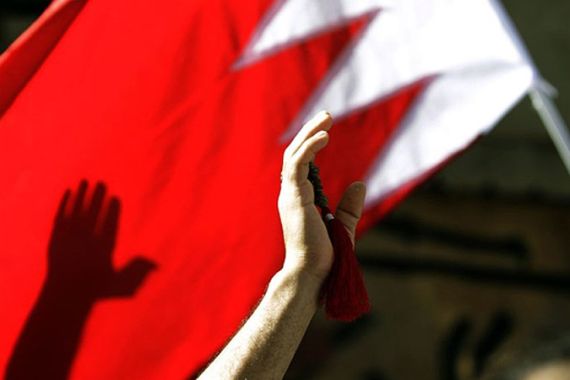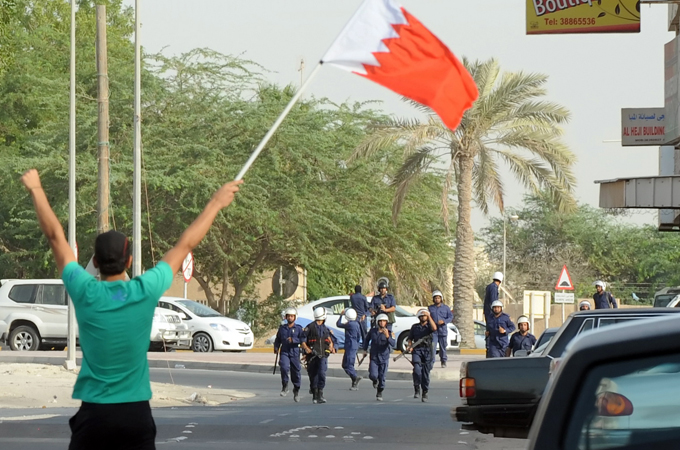Bahrain police ‘suppress protest’
Witnesses say police fired tear gas and rubber bullets at protesters marching in capital, Manama.

 |
| Anti-government protests took place around the country after emergency laws were lifted on Wednesday [EPA] |
Bahraini police have fired tear gas and rubber bullets at protesters marching against the government near the capital Manama, witnesses say.
The crackdown on Friday came just two days after the tiny Gulf kingdom’s authorities lifted emergency rule.
The protesters in Manama were marching adjacent to the city’s Pearl Roundabout, which was the epicentre of weeks of protests against the kingdom’s Sunni rulers, with demonstrators in particular demanding more rights for the island nation’s majority Shia population.
There were no immediate reports of injuries during the protests, the witnesses said. They spoke on condition of anonymity, fearing reprisals.
Witnesses said that police fired tear gas at a crowd of hundreds of people who had gathered to mourn Zainab Altajer, who died on Thursday. Opposition activists said she died as a result of exposure to tear gas, but the government said her death was due to natural causes.
|
This video, uploaded to YouTube by user Bhtv100, appears to show the security forces’ crackdown on protesters in Sanabis on Friday. Al Jazeera cannot independently verify the footage, as the Bahraini government has barred journalists |
The protesters marched through the village of Sanabis, adjacent to the Pearl roundabout.
Also on Friday, hundreds of mourners gathered at a cemetery in Manama to bury Salman Abu Idris, a 63-year old protester who died in hospital, earlier in the day, of injuries from a demonstration in March, a witness told Al Jazeera.
Security forces had set up multiple checkpoints around the cemetery in Gudaibya, where they were checking the identities of those attempting to attend the funeral, and refused entry to “many”, the witness said.
He said that people at the funeral were “calm”, and while some in the crowd did raise slogans against the ruling al-Khalifa family at one point, “not many people chanted with them”.
He said some left after the funeral to protest at the slums near Bab al-Bahrain, but were stopped by security forces armed with tear gas and rubber bullets. It did not appear that security forces used these weapons in that confrontation, however.
The witness was speaking to Al Jazeera on condition of anonymity, for fear of reprisals from the authorities.
Protests after emergency lifted
The Bahraini government lifted emergency rule in the country on Wednesday. Tanks and soldiers left the centre of the capital, but authorities said that they would still not stand for any protests against the government. This came as opposition groups called on supporters to return to the streets.
This was the first such appeal for protests since the military raided the roundabout in February, and martial law was imposed in mid-March.
At least 31 people have been killed in Bahrain since the protests, inspired by revolts in Tunisia and Egypt, began on February 14.
Bahrain’s rulers responded to the initial round of protests by inviting 1,500 troops from its Gulf neighbours (primarily from Saudi Arabia) to suppress the unrest under emergency laws.
Since the country lifted the emergency law on Wednesday, small protests have taken place in various villages and in Manama itself, rights groups have said. They said that they were met with tear gassing from the police.
“Instead of rights, every family got a political prisoner. Did the government expect people to stay at home?” said Nabeel Rajab, a leading activist and the Bahrain Center for Human Rights’ president. “After almost three months of military rule, the crisis is deeper because every family has suffered when the army was sent to solve a political problem.”
Hundreds of protesters, political leaders and Shia professionals such as doctors and lawyers have been arrested and tried in a special security court, set up under martial law. Two protesters were sentenced to death.
Formula One on track
Also on Friday, Formula One’s governing body decided at a meeting in Barcelona to allow Bahrain’s Formula One Grand Prix to go ahead. The race had initially been scheduled for March, but has now been put on the calendar for October 30.
Speaking to Al Jazeera, Tom Porteous, deputy programme director at Human Rights Watch, said the state of emergency appeared to have been lifted partly “for the benefit” of the Formula One race.
 |
| Click here for more of Al Jazeera’s special coverage |
But he said the crisis in the country was continuing and that protesters remained at risk.
“The fact is … the crisis is by no means over. Not only since [the lifting of emergency rule] have there been protests, violently suppressed … but also the repression by which the government has kept quelled the protest movement in the last weeks continues. So large numbers of people are under incommunicado detention, at risk of torture. There are reports of torture continuing. There are layoffs right, left and centre against people who took part in the protests,” he said.
“The abuses that we’ve seen in Bahrain actually predate the imposition of the state of emergency … and it was clear that this state of emergency was lifted in part to send a message that everything is back to normal in Bahrain, and partly for the benefit of the Formula One movement.
“But the situation remains appalling. The repression is there. Obviously large numbers of people were killed during the protests, proportionate to the size of the country. This is a major crisis, and it’s part of the wider situation in the Middle East.”